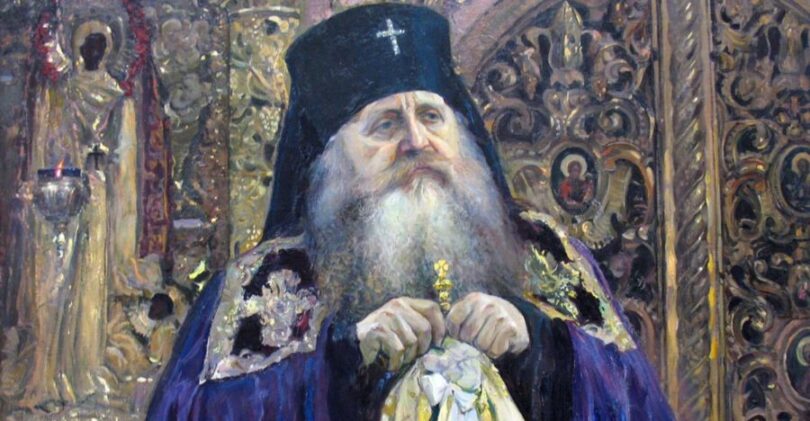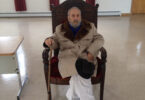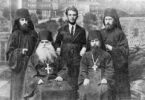In 1965, on the occasion of the funeral of Metropolitan Anastasii (Gribanovskii), the second chief hierarch of the Russian Orthodox Church Outside Russia, Metropolitan Philaret spoke these words:
“Who was most remarkable, greatest, most illustrious in the history of the Russian Orthodox Church during all these years and decades of our sorrowful and terribly evil times? Three names come to everyone’s mind. The first of these is, of course, the name of the All-Russian benefactor, pastor of all Russia, who was able, under completely incredible conditions… to preserve the Church’s freedom. I am referring to His Holiness, Tikhon, unforgettable Patriarch of Moscow and All Russia.
The second name, so dear to us children of the Church Abroad, is of that great prelate who, at a time when His Holiness, Tikhon, was defending the truth and freedom of the Church within Russia, was abroad… building something new and unprecedented. With God’s help, with his clear and profound mind and broad prelate’s heart, he was able to lead Russian people abroad onto the holy, canonical, spiritually-healthy path, becoming the founder of our Church Abroad. This was that unforgettable Father, the Blessed Metropolitan Antonii [Khrapovitskii].
And behold, a third name, one which is now on the lips of each one of us: the name of our beloved father, who was able to be, at one and the same time, the head, leader, and chief representative of our Church Abroad, Metropolitan Anastasii [Gribanovskiij].” [1] Orthodox Life, (May/June 1965).
Indeed, the history of the exiled Russian Church has been “writ large” by the personalities of her chief hierarchs, for the unique character of each one has had a profound effect on the historical development of this jurisdiction — particularly in America, as we shall see.
Metropolitan Antonii was born on March 17, 1863. Graduating from the St. Petersburg Theological Academy in 1881, he took monastic tonsure and served as Old Testament professor at the same academy. Because of his zealous personality — which demanded that students view spiritual life with uncommon sobriety — and his enormous intellectual gifts, he was transferred to the Moscow Theological Academy as rector in 1890 and, in 1894, to the Kazan Theological Academy, where he initiated training for missionaries to work among the Tartars. Everywhere he traveled, he gathered around him ardent disciples and admirers, many of whom, inspired by his example, entered the monastic life. Quite a few of them later became bishops.
In 1897, at the age of only thirty-four, Antonii was elevated to the episcopacy and, in 1912, was named a permanent member of the Holy Synod of Moscow where, for long years, he had supported the restoration of the Patriarchate. After the All-Russian Sobor and the election of Patriarch Tikhon, left-wing nationalists imprisoned him for eight months in a Uniate Monastery. Later, in both Constantinople and in Serbia, the immense personal respect accorded him by other Orthodox hierarchs—including non-Russian bishops — gave the newly born Russian Church Outside Russia considerable initial prestige. Even Dimitrii Pospielovskii, a recent severe critic of the Russian Church Abroad, concedes this. “A very important factor,” he writes, “in assuring the longevity, importance, and influence of the Karlovci schism was the personality of Metropolitan Antonii himself, one of the most influential bishops and conservative theological reformists in the Russian Church before the Revolution, whose influence and theological authority reached far beyond the frontiers of the Russian Empire in the world of Orthodoxy.” [2] The Russian Church Under…, op. cit., p. 128.
If this is the evaluation of an “enemy,” the following tribute, spoken after Antonii’s death by an admirer, the Serbian theologist Archimandrite Justin Popovich, is not surprising:
“I find myself in the position of an ant who must speak about the soarings of an eagle… It is possible from the ant’s perspective to admire the eagle soaring in the heavens, and to stand frozen by the awe of sweet delight… Make no mistake about it, the blessedly reposed Metropolitan is an exceptional patristic phenomenon in our time. Looking at him, I say to myself: “Yes, even now, one can actually live in a patristic manner, even now one can actually be a bishop like the Holy Fathers.” He is the sole patristic manifestation in our day… [italics added] Equally close and dear to him were Orthodox Syrians, Greeks, Bulgarians, Romanians, and Serbs. In his vast soul, a place was found for all the Orthodox.” [/ref] Orthodox Life, (September/October 1984). [/ref]
And not only for the Orthodox, for Metropolitan Antonii also had enormous missionary zeal — reaching out in person even to bishops of the Church of England in an effort to draw them back to historic Orthodoxy.
Few now remember, but in 1925, when the Church of England organized jubilee solemnities to commemorate the 1600th anniversary of the First Ecumenical Council (Nicea), Metropolitan Antonii attended, as did representatives of the Patriarchates of Constantinople, Alexandria, Antioch, and Jerusalem. During a solemn Eucharist in Westminster Abbey, at which all of the Eastern hierarchs were present (but did not celebrate with the Anglicans), the Orthodox Creed was read aloud in Greek by Patriarch of Constantinople Photios II.
At a special banquet attended by the Orthodox and Anglican prelates, Metropolitan Antonii gave his “witness” to the fullness of the Orthodox Faith, stating that although “all heterodox confessions are lacking in hierarchical grace… if any Anglican bishop or cleric were to desire to enter the Orthodox Church, then he could be received in the third rank — that is, without a second consecration — in other words, in his existing rank.” He explained, however, that this was not to be interpreted as a recognition of “Anglican Orders,” but that an Orthodox bishop, through the exercise of “economy,” could “receive clerics of heterodox confessions… without a new ordination… through the mystery of repentance (confession).” [3] Translated from Zizneopisanie blazenejsago Antonija, Mitropolita kievskago i glaickago, Tom VII.
In March 1925, Patriarch Tikhon died under circumstances so mysterious that he is now considered a martyr. In November of the same year, Metropolitan Petr of Krutitsk was recognized as the guardian of the patriarchal throne (locum tenens) by the Temporary Synod of Moscow. After the Soviets sentenced him to internal exile, in 1926 he was succeeded by Metropolitan Sergii of Nizhni-Novgorod as deputy locum tenens.
While the Church inside Russia was struggling at every level to survive, the Church Outside Russia was also undergoing severe and enormously complicated stresses and strains. After refusing to accept correction and supervision from the Synod of the Church Abroad, Metropolitan Evlogii of Paris (under whom most of the parishes of Western Europe had been prior to the Russian Revolution) was suspended in January of 1927. He responded by going into schism from the Synod. Two bishops of his archdiocese, however — Archbishop Seraphim of London and Bishop Tikhon of Berlin — returned to the jurisdiction of the exiled Synod in Karlovci.
Meanwhile, Metropolitan Sergii in Moscow issued a number of statements supporting the principle by which the Church Outside Russia had organized herself. What the Synod had done, he concluded, “obviously corresponds better to the existing circumstances of our Church.” [4] A History of the Russian Church Abroad…, op. cit., p. 38. Thus, “while seeking what was soon shown to be impossible, (namely a modus vivendi with atheist Communists), [Metropolitan Sergii] gave very responsible advice to the Russian Church Abroad… simply expanding the force of Patriarch Tikhon’s Ukaz No. 362 of 1920 to cover the life of the Church Abroad more explicitly.” [5] Ibid.
It is important to keep in mind that, historically and canonically, an Orthodox diocese, much less a whole jurisdiction, is never established independent of a “Mother Church” or Patriarchate. The “good order” of the Church demands that precedent always be followed, which means, that under, normal circumstances, 6migrds from the territory of a particular Patriarchate would simply be absorbed under the existing bishop of the diocese to which they had gone. If no Orthodox jurisdiction already existed there, the refugees could petition their Patriarchate to establish one.
Following the Russian Revolution, several million refugees fled to Europe, the Americas, and various parts of Asia, creating an extraordinary situation, unprecedented in all of Orthodox history, since the exiles also numbered among them scores of bishops, priests, and monastics. While the strict “rule” that one should be absorbed into already existing jurisdictions could have been followed, the incredible trauma of the Revolution and the savage religious persecution and purges in the homeland drew the émigrés together wherever they went, giving impetus to the organization of their own jurisdiction, with their own Synod of Bishops, even if this meant geographical and (under normal circumstances) uncanonical “overlapping” with other jurisdictions. However, for the Russian exiles to do this with any credibility, they had to have at least implicit support and recognition from the “Mother Church” in Russia. This, they felt, they had received from Patriarch Tikhon, and later from Metropolitan Sergii in his role as Patriarchal Guardian. Now, however, the situation was about to change abruptly — and just at the time, the Church Abroad was suffering its first major defections.
As a result of Metropolitan Sergii’s approval of the Church Outside Russia, the Soviets ordered him to excommunicate all bishops in exile on the grounds that they were vociferously anti-Communist and pro-monarchist. He refused, and government officials arrested him in December 1926. For nearly four months, Sergii was imprisoned until, quite suddenly and unexpectedly, he was released in order to issue an important “Declaration” (July 1927), in which he reversed his previous position concerning the Church in Exile, demanding “from the clergy abroad a written promise of their complete loyalty to the Soviet government in all their public activities,” failing which, they “shall be expelled from the ranks of the clergy subject to the Moscow Patriarchate.” Worse yet, Sergii then declared that Orthodox believers in the Soviet Union must be “faithful citizens… loyal to the Soviet government. We wish to remain Orthodox and at the same time to recognize the Soviet Union as our civil fatherland whose joys and successes are our joys and successes, and whose misfortunes are our misfortunes. Every blow directed against the [Soviet] Union… we acknowledge as a blow directed against us.” [6] Ibid., p. 39.
The Russian Orthodox Church Outside Russia felt that this was both a betrayal of the Faith and a kiss of death to the Church suffering behind the Iron Curtain. Even within the Soviet Union, many prominent hierarchs refused to acknowledge the “Declaration,” thus giving birth to a secret “catacomb-style” or underground Church, complete with its own bishops, priests, and monastics, which has existed even to the present day. Metropolitan Evlogii, in schism from the Church Abroad, informed Sergii that he and his clergy could not take this “oath of loyalty.” Later, though, when it was promised that he would be the official representative, the exarch, of the Patriarchate of Moscow abroad, he capitulated. And still later, when Evlogii finally began to speak out against the persecution of believers in the Soviet Union, he was deposed by Moscow. (Attempts at a reunion with the Church Abroad in subsequent years failed and, immediately after World War II, Evlogii again submitted himself and his parishes to Moscow through the newly elected Patriarch of Moscow, Aleksii).
Meanwhile, in June 1928, the Karlovci Synod was judged guilty of disobedience and schism by the Moscow Patriarchate and the entire Church Abroad was formally condemned and expelled. Even so, the Synod Abroad continued to be recognized by numerous other Patriarchates and self-governing Churches, including Jerusalem, Antioch, Cyprus, Sinai, Romania, Bulgaria, and, of course, Serbia, all of which clearly understood that Moscow’s decision had been coerced by the Soviets and therefore without validity or significance.
The Russian Orthodox Church Outside Russia thus found herself in a completely unprecedented situation. Neither a self-governing (autocephalous) church, nor an organic branch of the Moscow Patriarchate, she now described herself in the following way: historically part of the “Mother Church,” she is that free branch of the Russian Church outside the territorial bounds of Soviet Russia, dogmatically united to the enslaved Patriarchate in all that is not compromising but spiritually united to the Catacomb Church of Russia. When “the enslavement of the Moscow Patriarchate [is] brought to an end, the Church Abroad, after carefully ascertaining that the Russian Church [is] in fact free, [will] integrate herself again with the Patriarchal Russian Orthodox Church.” [7] Ibid., p. 60. This has been the official posture of the Church Abroad to this day, but one which has had to be stated and restated in each decade, to accommodate changing conditions both in the Soviet Union and in the diaspora, as we shall see in later chapters.
But, meanwhile, the Russian Church Outside Russia was focused on dealing with its own problems of existence in North America.
References











